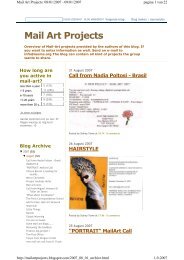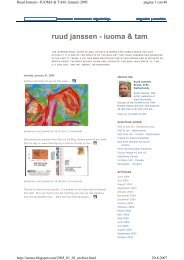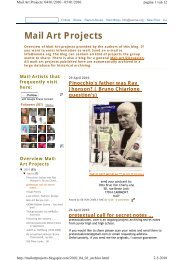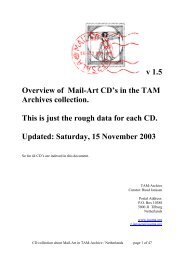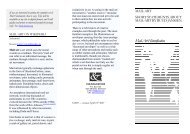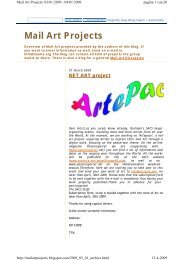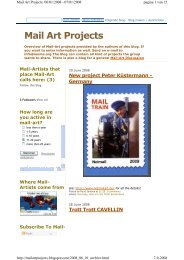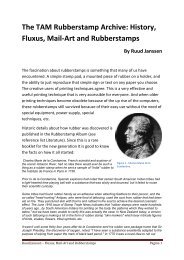Géza Perneczky - Ruud Janssen
Géza Perneczky - Ruud Janssen
Géza Perneczky - Ruud Janssen
Create successful ePaper yourself
Turn your PDF publications into a flip-book with our unique Google optimized e-Paper software.
°Mohammed. Invs. / Docs. In Ulises Carrión's archive: Concept of the project on <br />
three A/4 xeroxed sheets, 1 sheet colour xerox copy («convovcation»),<br />
+ 15 «convocations» by John Held Jr., + 45 «convocations» for Carrión<br />
by div. senders.<br />
Mohammed / Yearbook of the restricted Comm. Centre (with the gallerist Rinaldo <br />
Rotta) Three editions in the years 1978-80<br />
~<br />
Literature: «...Born of a Turkish father and a Genovese mother, we find a rather striking man,<br />
energetic, vital and full of life. What he has devised is a network, a system whereby<br />
as he says, „Mohammed goes to the mountain, rather than vica-versa. Mohammed<br />
goes to you.“<br />
Starting in 1976, he set up his Centro di communicazione ristretta (Center of<br />
restricted communication)... now he has gone far beyond 1,000 „unità“... Each<br />
„unità“ is completed in iteself; but some can be connected with others, and so the<br />
network continues. According to Mohammed, „the history of art is finisehd, but art<br />
is not finished.“(...)<br />
There is a spiritual content to this operation. As Mohammed says, „unità“<br />
means unit, which to him means harmony. This leads to a creation of a world, if not<br />
the world. Someone once said to him: „You are not Mohammed, you are Allah.“ He<br />
is not trying to play God, But only serve as a medium, an intermediary between an<br />
author-artists and 12 recipients...»<br />
(J. A. Hoffberg: Profile: Mohammed, Genova. In: Umbrella [→ Hoffberg],<br />
Vol. 4, #1, 1-2 p. 1981)<br />
«When Mohammed writes that he is only going to get out 10 or 20 piece of mail art<br />
each month in comparison to 40 or 50, there is a problem. He feels tjat mail art now<br />
creates the need for selection because he feels that „Mail art has ended in stupidity<br />
and in vulgarity. There are things that arrive here that I cannot print...»<br />
( jah: Mail Art: Crisis & Concern. In: Umbrella [→Hoffberg], 4 / #2, 35 p.)<br />
«Within the mail art cosmos, Mohammed is one fascinating, enigmatic subsystem.<br />
As a „center of restricted communication“ Mohammed acts as a transmitter of<br />
information and art – a kind of switchboard for images predicated upon a presribed<br />
set of rules.<br />
Here's how it works: An artist might have a message or an image s/he wishes<br />
to dispatch. In order to do so via Mohammed, the creator sends an original with the<br />
printed Mohammed masthead on it to the Center. Along with it must come the<br />
names and addresses of 12 people who are to receive a reproduction copy of the<br />
original (usually made by color xerography). Then the Center selects particular<br />
images from all received and reproductions go out to the 12 named by the artist.<br />
As well archival copies are made, two stay at the Center, another is sent to the Jean<br />
Brown Archive in Massachusetts. Each message or image is numbered and labelled<br />
as a „Unità“ by Mohammed. „Unità“ or unity in English is the manner in which this<br />
message reaches all those involved by the artist's wish. It is thought of as a small<br />
but discrete bit of harmony for participants to the process. Perhaps, too, Mohammed<br />
(the name of the Islamic deity) gets to „play god“. That is the artist creates and<br />
names disciplels or followers, but it is all orchestred via Mohammed. The Center<br />
„pulls the strings“ and makes the process complete.<br />
Well over a thousand origional messages have been sent via Mohammed<br />
over a three year period. Exactly who created the images and where they have been<br />
directed is scupulously recorded and published in a yearbook that one senses the<br />
depth and commitment of the Center...<br />
Mohammed, as a process, rages against depersonalization in communication<br />
and alludes to an essence and sensitivity as to he ways in which what we send<br />
becomes known to its receivers. Mesciulam, in one yearboook, refers to Noah, the<br />
makers of the Ark. In that context he sees Mohammed as a builder of lifeboats that<br />
float upon a flood of mass communication.»




